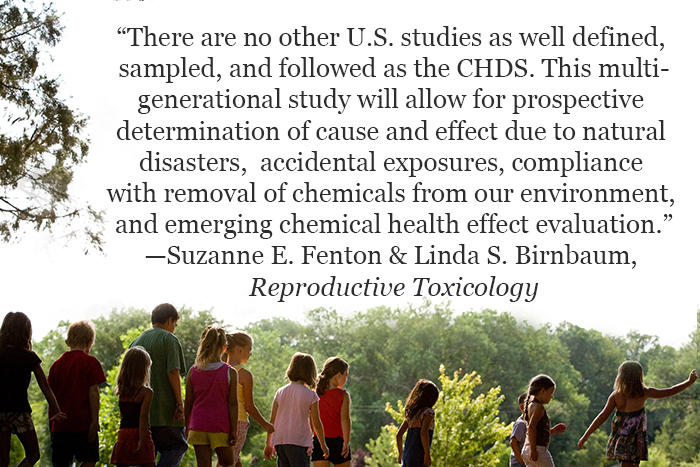
Update
PHI’s Child Health & Development Studies: “A National Treasure That Keeps on Giving”
-
Focus Areas
Environmental Health -
Issues
Cancer -
Programs
Child Health and Development Studies

For over 50 years, PHI’s Child Health and Development Studies (CHDS) has investigated how health and disease are passed on between generations—not just by genes, but also through social, personal, and environmental surroundings.
In the Spring 2020 issue of Reproductive Toxicology, Suzanne Fenton, Group Leader, Reproductive Endocrinology, National Institute of Environmental Health Sciences, and Linda Birnbaum, Director Emeritus, National Institute of Environmental Health Sciences, highlight the impacts and importance of the CHDS study—the only existing opportunity for 3-4 generational research in the impact of environmental chemicals during critical windows of pregnancy in the womb.
Access the full commentary
The commentary is part of a special issue of Reproductive Toxicology, comprised of 13 articles and two distinguished commentaries on the relation of exposures in pregnancy to the risk of breast cancer in mothers and their daughters.
“As samples and health information from multiple generations continue to be collected, the true value of the CHDS has yet to be seen. The CHDS needs funding to keep it going—it is a pearl whose market value is not yet established.”
– Suzanne E. Fenton and Linda S. Birnbaum CHDS: A national treasure that keeps on giving
 Between 1959 and 1967, over Bay Area 15,000 families joined the CHDS study when a woman first thought that she was pregnant—participating in comprehensive interviews about their health, lifestyle, and experiences that might influence the progress of pregnancy and the health of their infant. Today, CHDS scientists continue to use these samples and data to investigate the relationships between biologic, behavioral, genetic, and environmental factors in early family life to health outcomes in adults. The CHDS has begun a new era of follow-up studies on CHDS children, now adults, and their children.
Between 1959 and 1967, over Bay Area 15,000 families joined the CHDS study when a woman first thought that she was pregnant—participating in comprehensive interviews about their health, lifestyle, and experiences that might influence the progress of pregnancy and the health of their infant. Today, CHDS scientists continue to use these samples and data to investigate the relationships between biologic, behavioral, genetic, and environmental factors in early family life to health outcomes in adults. The CHDS has begun a new era of follow-up studies on CHDS children, now adults, and their children.
Because CHDS researchers have followed CHDS families since the 1950s, the cohort spans generations—allowing important scientific questions to be answered inexpensively, without waiting 50 years. Through these studies, CHDS scientists are working to uncover ways to prevent disease early in life.
Key findings from Child Health and Development Studies
- Prenatal DDT Exposure Tied to Nearly Four-fold Increase in Breast Cancer Risk: In 2015, research from CHDS found that women who were exposed to higher levels of the pesticide DDT in utero—particularly a more estrogenic form, o,p’-DDT, found in commercial DDT—were nearly four times more likely to be diagnosed with breast cancer as adults than women who were exposed to lower in utero levels.
- Producing Lifesaving Research: Women with Irregular Menstrual Cycles at Increased Risk of Ovarian Cancer Death: A 2016 study CHDS uncovered that women with irregular menstrual cycles had up to a threefold increased risk of developing ovarian cancer and dying from it—allowing clinicians to identify a new high-risk target for more intensive ovarian cancer screening and the opportunity for earlier intervention and life-saving treatment.
- Linking PFAS Exposure & Multi-Generational Obesity: In 2020, CHDS released the first human study to link blood levels of certain PFAS (known as “forever chemicals) in pregnant women to their granddaughters’ obesity risk—adding to a growing body of evidence highlighting the harmful impacts of certain environmental exposures to the health of future generations.
More Updates
Work With Us
You change the world. We do the rest. Explore fiscal sponsorship at PHI.
Support Us
Together, we can accelerate our response to public health’s most critical issues.
Find Employment
Begin your career at the Public Health Institute.



